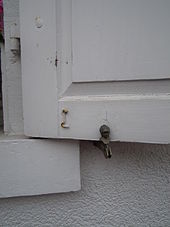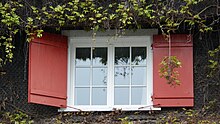Shutter holder
Shutter holders ( English : "Shutter dogs"; French : "Crochet de volet", "Arrêt de volet") are used to hold open shutters and count among the window fittings . There are shutter holders in a wide variety of designs. These are also called shutter-lock , lock , store holder , loading retainer , load lock, window shutter holder or shock loading holder also or after the external shape of the movable part as: Schäfer head , students head , Amazon head , female head , Ritter head , male referred etc..
So-called latches have multiple functions as fittings in window construction . These are used both inside and outside to open or hold windows, casements or shutters. The quarter turn as a shutter holder is a simple, rotatable metal flag.
The shutter holder has a similar function to the storm hook and is used to keep the shutters open permanently parallel to the wall construction. The storm hook as a window hook can, however, also enable several different positions of the shutter, not just parallel to the masonry.
Material and assembly


Shutter holders are mostly made of metal, such as ordinary iron , forged iron or cast iron , sometimes galvanized , painted or coated with plastic .
Shutter holders can be screwed or clamped (walled in) or screwed into the wall construction or the window frame. The shutter holders are usually attached independently of the window hinges .
DIN 18357 is to be applied to the attachment of shutter holders. Based on EN 14648, DIN EN 14648 applies to Germany with regard to fittings for window shutters and their requirements and test methods (in Austria: ÖNORM EN 14648).
Layout and function
A shutter holder has a movable and a fixed part. The fixed part is connected to the wall structure or the frame. When open, the movable part allows the shutter to be guided out of the holder and closed. When closed, the movable part prevents the shutter from leaving its (mostly) parallel position to the wall structure by itself or as a result of external influences. As long as the movable part of the shutter holder locks the shutter, the shutter cannot be closed. The shutter holder has no function when the shutters are closed.
The simplest version is the shutter holder with a rotating metal flag ( quarter turn ). In some cases, shutter holders are also offered in self-locking versions. Here, too, the quarter turn is technically the simplest construction for self-locking, in which one metal flag of the quarter turn is made heavier than the other.
Appearance
Shutter holders were and are manufactured in a purely functional design. In addition, various designs are preserved and available in the form of stylized human heads with or without headgear . In the case of shutter holders with a head, the heads generally “see” away from the shutter or the masonry.
Narrow chains (window chains, chains ) were also used as shutter holders (and at the same time locking the window or door, later a separate bolt) .
Similar designs
Door holders or flap holders are less common. In some cases, shutter holders are also used as a substitute to hold doors and flaps in place (especially quarter turn).
literature
In the literature, shutter holders are hardly considered or mentioned. In " Two Lovers of Shades: Two Short Novels " by Alberto Manguel it is mentioned that shutter holders can serve as rungs for climbing a house wall. In “ A new beginning made to measure. “By Axel Fischer, the shutter holder serves as a way to fasten the reins of the horse.
In Christian Friedrich Sintenis' “ Max Wind and Co., or in the end they may all be smart ” , the clatter of a window label serves as a shy counter-greeting.
Web links
See also
Individual evidence
- ^ Silvio Mohr: Building construction: An encyclopedia of building materials and building structures. Springer Verlag, Vienna 1936, p. 254.
- ↑ According to the German dictionary. the owners of a shop were also called shopkeepers .
- ↑ After Johann Christoph Adelung : Grammatical-critical dictionary of the high German dialect. Vienna 1811, the term "Quarter Turn" for window fittings comes from "pre-rubbed" in the sense of "pre-turning". This is an iron " bent at one or both ends and movable around a strong nail ".
- ↑ For the function as a shutter holder see: Gustav Adolf Breymann : Allgemeine Baukonstructionslehre: with special reference to building construction. A guide to lectures and self-teaching. Volume 2, Stuttgart 1870, p. 243 (Google Books) and also Sonja Steiner-Welz: Window . Reinhard Welz Vermittler Verlag, Mannheim 2007, ISBN 978-3-86656-592-0 , p. 173, Fig. 384. (Google Books)
- ↑ Anette Hochberg et al.: Opening and closing: windows, doors, gates, loggias, filters. Birkhäuser, 2010, ISBN 978-3-7643-9960-3 , p. 89. (Google Books)
- ↑ Transylvanian-Saxon Dictionary, de Gruyter Verlag, Berlin 1925, p. 350. (Google Books)
- ↑ German dictionary , search term: Window window / Kettel. See also: Johann Karl Gottfried Jacobssons in Technological Dictionary or alphabetical explanation of all useful mechanical arts, manufactories, factories and craftsmen: as well as all works, instruments, tools and artificial words occurring there, according to their nature and true use. Berlin / Stettin 1781, p. 702. (Google Books) Also referred to as Fensterkôp in Luxembourgish : Jean François Gangler: Lexicon of Luxembourgish colloquial language. Verlag Hoffman, Luxemburg 1847, p. 146. (Google Books) Similarly: CF Ehrenberg: Baulexikon. Explanation of the most common technical and artistic expressions used in construction. Frankfurt am Main 1843, p. 214. (Google Books)
- ↑ Fischer Verlag, Frankfurt am Main 2013, ISBN 978-3-10-048755-1 , (Google Books)
- ↑ Norderstedt 2014, ISBN 978-3-8391-4167-0 , p. 23.
- ↑ Frankfurt / Leipzig 1780, p. 194.



